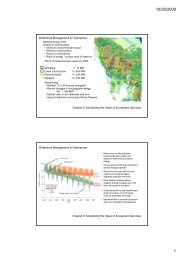RAINFOR GEM Intensive Plots Manual (pdf) - University of Oxford
RAINFOR GEM Intensive Plots Manual (pdf) - University of Oxford
RAINFOR GEM Intensive Plots Manual (pdf) - University of Oxford
- No tags were found...
Create successful ePaper yourself
Turn your PDF publications into a flip-book with our unique Google optimized e-Paper software.
2.2 RhizotronsRoot observation pits with screen rhizotrons are a method for measuring surface root growth (≤30 cm depth) intropical field sites 45 , allowing more regular readings than in-growth cores (monthly as opposed to threemonthly)(Metcalfe et al. 2008a, Girardin et al. 2010). In the Kosñipata valley, Peru, we have found closeagreement between rhizotron and in-growth core methods (Girardin et al. 2010), but it is strongly advised toimplement both protocols.See Box 4 for how to construct rhizotrons.Rhizotron installationEquipment: 6 long (15 cm) nails per rhizotron (if using a metallic rhizotron made <strong>of</strong> MFCs, see Box 4), flatedged spade, broad hoe/pick axe, hammer, plastic sheets (~1 m 2 , e.g. bin-liners) and a metallic grid (~70 cm ×70 cm) to prevent animals (or people) falling into the rhizotron holeIdeally, installation should take place in the dry season otherwise high rainfall can soon erode the contactbetween the screen and the soil. If the plot is a regular square, install the rhizotrons in a 3 × 3 grid as shown (ifnot square, get as close to this as possible; also try to position the rhizotrons so as to avoid where the transectsfor coarse woody debris surveys will be placed - see §4.2). Because <strong>of</strong> foot traffic along the subplot edges,place the rhizotrons 1-2 m away from the edges (and the central one 1-2 m away from the middle). At therhizotron location, permanently mark a 1.0 m × 1.0 m exclusion area (e.g. with flagging tape) which shouldremain strictly disturbance-free no only during installation <strong>of</strong> the rhizotron but also afterwards (especially nocutting!). Using the spade and trowel, dig a rectangular hole in front <strong>of</strong> the exclusion area that is ~30 cm across(as close as possible to the exact width <strong>of</strong> the rhizotron), 50 cm long (length <strong>of</strong> a forearm + 10 cm) and ~40 cm45 Unfortunately, experience at the Wytham Woods plot, UK, has shown that this method is unsuitable for some clay-rich temperateplots because <strong>of</strong> the large amounts <strong>of</strong> soil contraction and expansion during the year. It is also problematic at sites with seasonallyshallow water tables.37





